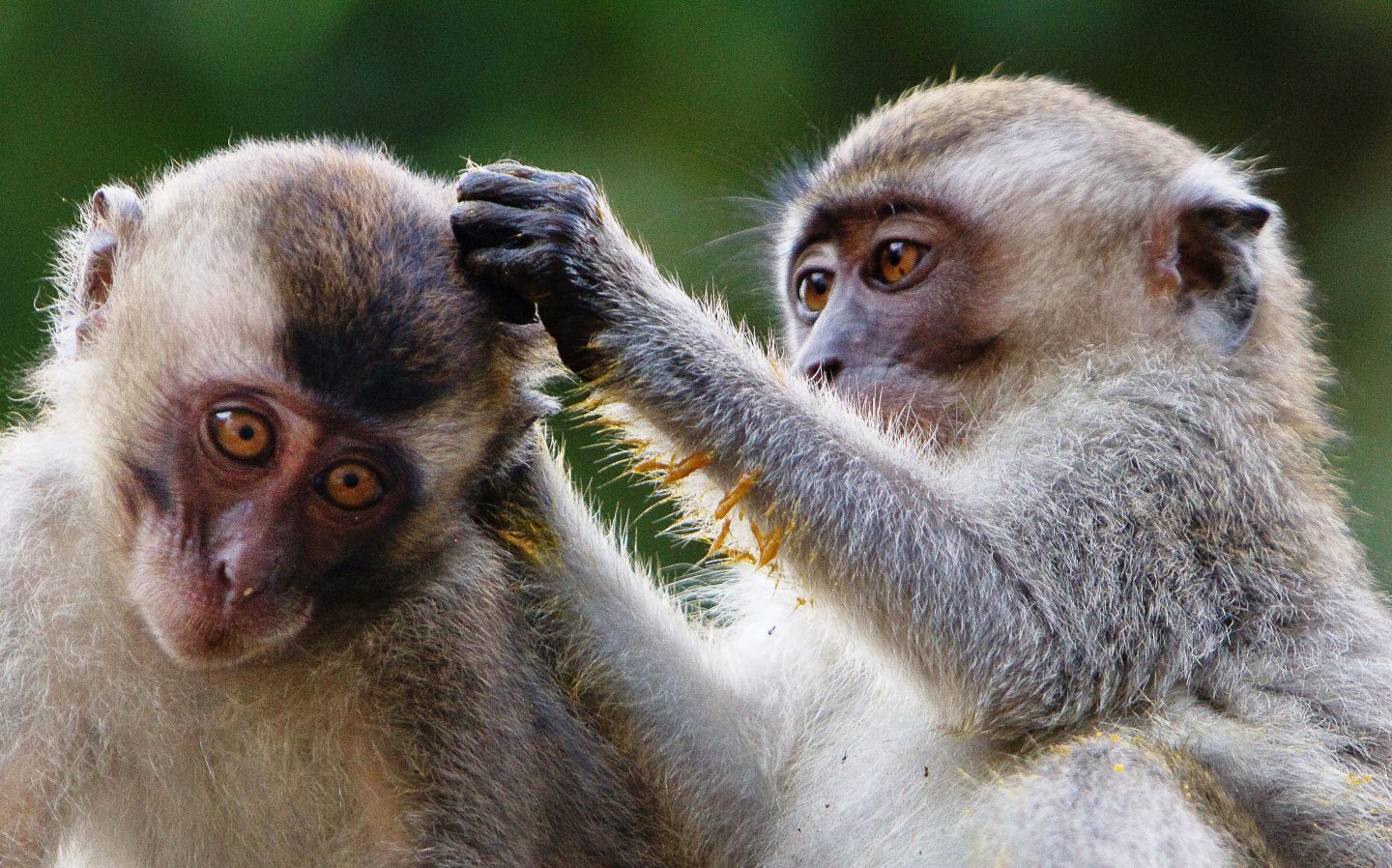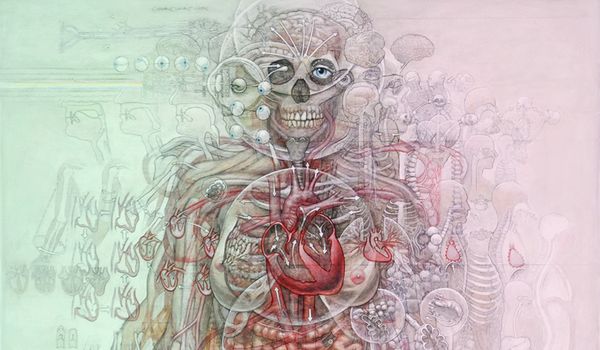Steve Taylor • • 16 min read
Alternative Human Nature: Why Kindness and Cooperation are More Natural Than Selfishness

For a long time, there has been a general assumption in our culture that “human nature” is essentially bad. Human beings — so it has been assumed — are strongly disposed to traits like selfishness, domination, and warfare. We have powerful natural impulses to compete with one another for resources, and to try to accumulate power and possessions. If we are kind, it’s usually because we have ulterior motives. If we are good, it’s only because we have managed to control and transcend our natural selfishness and brutality.
This view of human nature has been justified by biological theories like the “selfish gene” (as popularised by the UK science writer Richard Dawkins) and the field of evolutionary psychology. Evolutionary psychology describes how present-day human traits developed in prehistoric times, during what is termed the “environment of evolutionary adaptedness” (EEA). The EEA is usually seen as a period of intense competition, when life was a kind of Roman gladiatorial battle in which only the traits that gave people a survival advantage were selected, and all others fell by the wayside.
For example, evolutionary psychologists have suggested that men have a strong urge to gain wealth and power because, in prehistoric times, this enhanced their chances of survival and increased their reproductive possibilities (1). Others have suggested that human beings have such a strong impulse to fight wars because prehistoric tribes of genetically similar people were in constant competition for resources with other groups (2). Similarly, racism has been seen as an adaptation that developed because altruism towards another group would have decreased a group’s own chances of survival. It was beneficial to deprive other groups of resources and power in order to increase our own access to them. In the words of Pascal Boyer, for example, racism is “a consequence of highly efficient economic strategies”, enabling us to “keep members of other groups in a lower-status position, with distinctly worse benefits” (3).
All of this may seem logical. But in fact the assumption these views are based on — that prehistoric life was a competitive struggle for survival — is completely false.
Prehistoric Peace and Abundance
It is important to remember that in the prehistoric era, the world was very sparsely populated. As a result, it is likely that there was an abundance of resources for hunter-gatherer groups. According to some estimates, around 15,000 years ago, the population of Europe was only 29,000, and the population of the whole world was no more than half a million (4). With such a small population density, it seems unlikely that prehistoric hunter-gatherer groups had to compete against each other for access to resources, or had any need to develop ruthlessness and competitiveness or to go to war.
It is also highly unlikely that groups ever became so large that they would exhaust the resources of a particular area, since they moved sites regularly – usually every few months – and experienced very little population growth. (They may have exhausted the resources of very small local areas – thus necessitating a move – but not of the wider area.)
The world’s population grew exceedingly slowly throughout prehistory – by well below .001 percent per year, according to one estimate (5). Before the emergence of agriculture, it is likely that it took tens of thousands of years for the world’s population to double. Anthropologists have puzzled over this lack of population growth, but suggested reasons include longer periods of breastfeeding (up to the age of 5 or 6, resulting in extended periods of infertility), and the use of plant contraceptives. Certainly, a small number of children would suit the mobile hunter-gatherer lifestyle, since larger numbers would have been difficult to transport to new sites. The idea of life as a competition for limited resources only has validity in relation to a settled, agricultural lifestyle. It has no meaning in terms of the mobile hunter-gatherer lifestyle our species followed for the great majority of our time on this planet.
There are other ways in which prehistoric life was relatively easy too. Hunter-gatherers had a good diet – one that was arguably better than many modern peoples’, with no dairy products and a wide variety of fruits, vegetables, roots and nuts, all eaten raw, as well as meat. (6) This partly explains why skeletons of ancient hunter-gatherers are surprisingly large and robust, and show few signs of degenerative diseases and tooth decay. Studies of skeletons have shown, for example, that the hunter-gatherers of prehistoric Greece and Turkey had an average height of five feet ten inches for men and five feet six for women. But after the advent of agriculture, these declined to five feet three and five feet one respectively (7). Research from many different areas shows that the adoption of farming brought about a deterioration in terms of body size and stature, general health and life expectancy (8).
Prehistoric hunter-gatherers were also much less vulnerable to disease than later peoples In fact, until the advances of modern medicine and hygiene of the 19th and 20th centuries, they may well have suffered less from disease than any other human beings in history. Many of the diseases that presently afflict human beings were passed on to us by animals we domesticated (9). In a recent review of the relationship between agriculture and human disease, the United Nations’ Food and Agriculture Organisation found that almost three-quarters of human diseases originate in animals (10). In view of this, it is not surprising that with the development of agriculture, people’s lifespans became shorter.
In fact, a good deal of research suggests that the health of prehistoric hunter-gatherers was superior to most modern human beings, with lower blood pressure, good insulin sensitivity, lower body mass index, and better bone health (11). In a study of contemporary hunter-gatherer groups, Gurven and Kaplan have found that a longevity not far below that of the world’s most affluent industrialized countries. As they summarised, “modal adult lifespan is 68-78 years, and it was not uncommon for individuals to reach these stages” (12).
In other words, the era of evolutionary adaptedness did not appear to feature a frenzied struggle for survival, as envisaged by evolutionary psychologists. The point is that, if prehistoric human life was not an intense competition, then evolutionary psychology’s explanations for traits such as racism, rape, competitiveness or male dominance make little sense. Wherever these traits came from, it seems highly problematic to see them as genetic adaptations, and to see them as “innate” features of human nature.
The Controversy Over Prehistoric Warfare
This becomes clearer in relation to the topic of warfare. According to one of the founding theorists of evolutionary psychology, E. O. Wilson (13), warfare is a “hereditary curse” of the human race, while Steven Pinker has suggested that “chronic raiding and feuding characterize life in a state of nature” (14). But this is far from what the evidence suggests.
In recent years, the notion of “prehistoric peace” idea has gained more evidence and support, and hence become much more widely accepted amongst anthropologists and archaeologists. Even an orthodox evolutionary psychologist such as David Barash has chastised Wilson and Pinker for their simplistic views on prehistoric warfare, stating that “a strong case can and has been made that nomadic forager social systems, in particular, predispose against violent interpersonal competition” (15).
The anthropologists Haas and Piscitelli surveyed descriptions of 2900 prehistoric human skeletons from scientific literature, and apart from a single massacre site in Sudan (in which two dozen people were killed), there were only four skeletons that showed signs of violence – and even these signs were consistent with homicide rather than warfare. This dearth of violence completely contrasts with later periods when signs of war become obvious from skeletal marks, weapons, artwork, defensive sites and architecture. As they wrote, “The presumed universality of warfare in human history and ancestry may be satisfying to popular sentiment; however, such universality lacks empirical support” (16).
Another anthropologist. Bryan Ferguson, has carried out a detailed survey of Neolithic Europe and the near East, and found almost no evidence of warfare. He has found that warfare only became common in these areas around 3500 BCE. In the Levant — an area which includes present-day Jordan, Syria, Israel and Palestine – there was also no sign of warfare until 3500 BCE, even though the area had been densely populated and farmed since 9000 BCE.
As Ferguson has summarised:
“By considering the total archaeological record of prehistoric populations of Europe and the Near East up to the Bronze Age, evidence clearly demonstrates that war began sporadically out of a warless condition, and can be seen, in varying trajectories in different areas, to develop over time as societies became larger, more sedentary, more complex, more bounded, more hierarchical” (17).
Lawrence Keeley’s (1997) book War Before Civilisation has suggested several examples of prehistoric violence and warfare, but all of these are dubious, and have been dismissed by other scholars. For example, Keeley has seen cut marks on human bones as evidence of cannibalism, when they are more likely to be the result of prehistoric funeral rituals of cleaning bones of their flesh. He also interprets highly abstract and stylised drawings in caves in Australia as depicting battles, when they are open to wide variety of other interpretations. In this way, as Ferguson has remarked, “Keeley’s rhetoric exceeds his evidence in implying war is old as humanity” (18).
Even modern-day nomadic hunter-gatherers are generally not territorial — that is, they do not think of a particular area of land as belonging to them and them alone, and do not aggressively resist anybody who encroaches on it. As the anthropologists Burch and Ellanna have put it, “both social and spatial boundaries among hunter-gatherers are extremely flexible with regard to membership and geographic extent” (19).
Rather than being in conflict, hunter-gatherer groups interact with each other a good deal. They regularly visit each other, make marriage alliances, and often switch membership. A recent study of 21 contemporary hunter-gatherer groups by the anthropologists Fry and Söderberg showed a striking lack of evidence for inter-group conflict over the last hundred years. There was only one society (an Australian Aboriginal group called the Tiwi) who had a history of group killings. (20)
In other words, the evidence strongly suggests that warfare is not innate, and only became prevalent at a late stage. Thus there is no evidence that the tendency for group conflict was selected as an evolutionary adaptive trait. And in view of the low population densities during prehistory, we have every right to ask: why should group conflict have been selected as an adaptive trait? What would have been the necessity for it, in a world without scarcity? As Haas and Piscitelli have put it, “For 190,000 years of human existence on the planet, low population densities obviated all the proposed biological or cultural reasons for warfare and intraspecific conflict” (21).
Group Conflict Amongst Chimpanzees and Bonobos
Violence amongst chimpanzees has been seen as evidence for the innate warlikeness of human beings, since they are closely related to us as a species. However, there have always been doubts about how common chimpanzee violence is, and — even where it does appear to be relatively common — how much of it is innate, or due to external influences.
Famously, the primatologist Jane Goodall studied the chimpanzees of Gombe in Tanzania, and her findings served as the basis for the ‘demonic male’ hypothesis of Wrangham and Peterson, suggesting that male primates — including human beings — are genetically programmed to be violent and murderous (22).
However, as Margaret Power pointed out, Goodall’s own early studies of the chimpanzees showed a lack of violence. In fact, 15 years went by without her witnessing a murder due to group conflict. And even after the chimpanzees became more violent, deaths from group raids were still very rare – only at a rate of one per seven years per community (23). More recent studies have also found that killings are very infrequent. As of 2004, a combined observer time of 204 years at a number of chimpanzee sites had only recorded 12 observed and 17 suspected chimpanzee-on-chimpanzee killings, equivalent to a rate of one killing every 7.5 years (24).
It also appears that levels of violence observed amongst chimpanzees — though not particularly high in the first place — are inflated due to the fact most research takes place in sites that are affected by to human encroachment and disruption (25). Disruptive factors include loss of habitat, poaching and hunting, disease, tourism, and demographic disruption (26). Studies of other chimpanzee groups in more undisturbed and natural environments show even lower levels of aggression Over many decades of observing chimps, the zoologist Francis de Waal has concluded that Wrangham’s picture of the species is extremely distorted, and ignores their benevolence and altruism, as well as the peace-making strategies they often employ. (27)
It is significant that human beings are as closely related to bonobos as we are to chimpanzees, and it has always been accepted that bonobos are extremely peaceful. Modern researchers have never observed a single incidence of group conflict or murder amongst them (28). Male bonobos do not dominate their groups, and their societies show no signs of hierarchical arrangements. Bonobo social Interactions are typically amicable. If they show any signs of aggression or any signs of social tension or disputes, it is often diffused by sexual activity. Bonobos frequently display empathy and altruism, not only to members of their own groups, but to “strangers”, and even to members of other species (e.g. helping injured birds). De Waal has suggested that bonobos are actually more representative of human beings than chimpanzees. This contradicts the idea that we have inherited our supposed innate war-like behaviour from “killer ape” ancestors. However, evolutionary psychologists have a striking tendency to concentrate on chimpanzees rather than on our peaceful other cousins.

Egalitarianism
Another aspect of the standard evolutionary psychology narrative contradicted by anthropological evidence is the idea that human beings are naturally competitive and self-centred. This also makes little sense in terms of the egalitarianism of nomadic hunter-gatherer or foraging groups. The anthropologist James Woodburn spoke of the “profound egalitarianism” of hunter-gatherer groups, describing how they “are not entitled to accumulate movable property beyond what they need for their immediate use. They are morally obliged to share it” (29). An example is the Hazda of Africa, who never own an “unnecessary” possession — such as a second axe or a second shirt — for more than a few days, and usually not more than a few hours. Their “moral obligation to share” makes them give it away almost immediately.
At the same time, some nomadic hunter-gatherer groups have methods of preserving egalitarianism by ensuring that status differences do not arise. This is done by sharing credit and putting down or ridiculing anybody who becomes too boastful. The !Kung of Africa swap arrows before going hunting, and when an animal is killed, the credit does not go to the person who fired the arrow, but to the person whom the arrow belongs to. If a person becomes too domineering or too arrogant the other members of their group gang up against them, or ostracise them. As Boehm has summarized, “This egalitarian approach seems to be universal for foragers who live in small bands that remain nomadic, suggesting considerable antiquity for political egalitarianism” (30).
There have also been attempts to explain patriarchy or male domination in adaptationist terms. Wrangham and Peterson have claimed, for example, that “Males have evolved to possess strong appetites for power because with extraordinary power males can achieve extraordinary reproduction” (31). Women’s desire for power is inevitably weaker because, for them, more power does not bring more reproductive possibilities – since, after all, the best they can do to replicate their genes is to have a baby every year or so. However, this explanation also makes little sense in terms of hunter-gatherer groups, where there is a striking absence of both sexual inequality and competition for power.
As the anthropologist Knauft has remarked, hunter-gatherers are characterized by “extreme political and sexual egalitarianism” (32). Or as Tim Ingold has noted, in “immediate return” hunter-gatherer societies (that is, societies that live by immediately using any food or other resources they collect, rather than storing them for later use), men have no authority over women (33). Women usually choose their own marriage partners, decide what work they want to do and work whenever they choose to, and if a marriage breaks down they have custody rights over their children. Other recent research on contemporary hunter-gatherer groups has shown that men and women tend to have equal status and influence, leading to the suggestion that sexual inequality only began to emerge with the development of agriculture (34).
It is perhaps significant here that, in economic terms, the role of women in hunter-gatherer groups is just as important (and often more important than) than the role of men. It is common for women to provide the majority of a group’s food, through gathering (a fact which has led to the suggestion that the groups should be renamed “gatherer-hunters”). Studies of Australian Aboriginal communities have found that there are frequent periods where most of a group’s food stems from roots, fruits and seeds foraged by women, rather than from meat hunted by men (35). Indeed, in some circumstances, men provided less than 10% of a group’s food (36).
Altruism and Egalitarianism
So there is no reason to think that selfishness and cruelty are natural to human beings. There is no reason why traits such as racism, warfare, and male domination should have been selected by evolution, since they would have had no benefit to us.
In fact, as we have seen, individuals who behaved selfishness and ruthlessly would be less likely to survive, since they would have been ostracized from their groups. On the contrary, it makes more sense to see traits such as cooperation, egalitarianism, altruism, and peacefulness as natural to human beings. These were the traits that were prevalent in human life for tens of thousands of years, during the so-called era of evolutionary adaptedness, and so presumably these are the strongest traits in us now.
Of course, you might argue that if this is case, why do present-day humans often behave so selfishly and ruthlessly, and why are negative traits like warfare and male domination, so normal to many cultures? However, we should perhaps view these traits as the result of environmental and psychological factors. Research has shown repeatedly that when the natural habitats of primates (such as chimpanzees) are disrupted, they tend to become more violent and hierarchical. So perhaps something similar has happened to us, since we gave up the hunter-gather lifestyle and switched to farming, and then started to live in towns and cities.
Another possible theory (which I put forward in my book The Fall) is that the “fall” into warfare and hierarchy (and other negative traits) was related to a psychological change that occurred in some groups of people, beginning around 6,000 years ago: the development of a heightened sense of individuality and separateness. At any rate, these negative traits developed so recently that it’s not feasible to explain them in adaptive or evolutionary terms. An alternative, more evidence-based evolutionary psychology would see human beings as having an innate disposition towards peacefulness, due to our long prehistory without warfare, and due to the peacefulness of our close cousins, bonobos.
It is therefore inaccurate to portray human beings as genetic machines who are only concerned with their own survival and replication, and whose selfish and ruthless nature is the inevitable consequence of their prehistoric struggle to survive. The “good” side of our nature is much more deep-rooted than the “evil” side.
Spiritual Science by Steve Taylor

Spiritual Science explains how the standard materialist model of reality developed, and turned into a belief system. This belief system can only function by denying (or explaining away) a whole range of phenomena that are part of human experience. It is possible to be scientific without adopting this belief system – in fact, it is much more rational to do so.
References
- Coombs, R. H., & Kenkel, W. F. (1966). Sex differences in dating aspirations and satisfaction with computer-selected partners.Journal of Marriage and the Family, 62-66.
- Buss, D. M., & Shackelford, T. K. (1997). Human aggression in evolutionary psychological perspective.Clinical Psychology Review,17(6), 605-619; Wrangham, R. W., & Peterson, D. (1996). Demonic males: Apes and the origins of human violence. New York: Houghton Mifflin Harcourt.
- Boyer, P. (2001). Religion Explained. London: Vintage.
- Haas, J., & Piscitelli, M. (2013). The prehistory of warfare: Misled by ethnography.In Fry, D. P (Ed.), War, Peace, and Human Nature. New York: Oxford University Press, 168-190.
- Hassan, F. A. (1980). Prehistoric settlements along the Nile.The Sahara and the Nile (MAJ Williams and H. Faure, Editors), 421-450.
- Cordain, L., Eaton, S. B., Brand Miller, J., Mann, N., & Hill, K. (2002). The paradoxical nature of hunter-gatherer diets: Meat-based, yet non-atherogenic.European Journal of Clinical Nutrition,56(1), S42; O’Keefe, J. H., & Cordain, L. (2004). Cardiovascular disease resulting from a diet and lifestyle at odds with our Paleolithic genome: how to become a 21st-century hunter-gatherer. In Mayo Clinic Proceedings 79 (1), pp. 101-108.
- Diamond, J. (1992). The Third Chimpanzee. New York: Harper Collins.
- Cohen, M.N. and Armelagos, G.J. (Eds.) (1984). Paleopathology at the origins of agriculture. New York: Academic Press.
- Pearce‐Duvet, J. (2006). The origin of human pathogens: evaluating the role of agriculture and domestic animals in the evolution of human disease.Biological Reviews,81(3), 369-382
- Slingenbergh, J. (2013).World Livestock 2013: changing disease landscapes. Food and Agriculture Organization of the United Nations (FAO).
- Carrera-Bastos, P., Fontes-Villalba, M., O’Keefe, J. H., Lindeberg, S., & Cordain, L. (2011). The western diet and lifestyle and diseases of civilization. Res Rep Clin Cardiol,2, 15-35.
- Gurven, M., & Kaplan, H. (2007). Longevity among hunter‐gatherers: a cross‐cultural examination.Population and Development review,33(2), 321-365.
- Wilson, E. O. (2012).The social conquest of earth. New York: WW Norton & Company.
- Pinker, S. (2011).The better angels of our nature: The decline of violence in history and its causes. New York: Viking Books, p. xxi.
- Barash, D. (2103). ‘Evolution and peace: A janus connection.’ In War, peace, and human nature: the convergence of evolutionary and cultural views. Oxford: Oxford University Press, 25-37.
- Haas, J., & Piscitelli, M. (2013). The prehistory of warfare: Misled by ethnography.In Fry, D. P (Ed.), War, Peace, and Human Nature. New York: Oxford University Press, 168-190.
- Ferguson, R. B. (2013). The prehistory of war and peace in Europe and the Near East.In Fry, D. P.(Ed.), War, peace, and human nature: the convergence of evolutionary and cultural views. Oxford: Oxford University Press, 191-240, p. 116.
- Keeley, L. H. (1997).War before civilization. New York: Oxford University Press.
- Burch, E.S. & Ellanna, L.J. (1994). ‘Editorial.’ In Burch, E.S. & Ellanna, L.J. (Eds.), Key Issues in Hunter-Gatherer Research. Oxford: Berg, p.61.
- Fry, D. P., & Söderberg, P. (2014). Myths about hunter-gatherers redux: nomadic forager war and peace.Journal of Aggression, Conflict and Peace Research,6(4), 255-266.
- Haas, J., & Piscitelli, M. (2013). The prehistory of warfare: Misled by ethnography.In Fry, D. P (Ed.), War, Peace, and Human Nature. New York: Oxford University Press, 168-190., p. 176.
- Wrangham, R. W., & Peterson, D. (1996).Demonic males: Apes and the origins of human violence. New York: Houghton Mifflin Harcourt.
- Power, M. (1991). The Egalitarians: Human and Chimpanzee. Cambridge: Cambridge University Press.
- Sussman, R. W. (1997). “Exploring Our Basic Human Nature: Are Humans Inherently Violent?” Anthronotes – National Museum of Natural History Bulletin for Teachers, 19, 3.
- Morgan, D., & Sanz, C. (2003). Naïve encounters with chimpanzees in the Goualougo Triangle, Republic of Congo.International Journal of Primatology,24(2), 369-381.
- Ferguson, R. B. (2000). The causes and origins of’ primitive warfare: on evolved motivations for war.Anthropological Quarterly,73(3), 159-164.
- De Waal, F. (2009).Primates and philosophers: How morality evolved. Princeton: University Press.
- Parish, A. R., de Waal, F., & Haig, D. (2000). The other ‘closest living relative’: How bonobos (Pan paniscus) challenge traditional assumptions about females, dominance, intra‐and intersexual interactions, and hominid evolution.Annals of the New York Academy of Sciences,907(1), 97-113.
- Parish et al., 2000; Furuichi, T. (2011). Female contributions to the peaceful nature of bonobo society. Evolutionary Anthropology: Issues, News, and Reviews, 20(4), 131-142.
- Woodburn, J. (1982) Egalitarian societies. Man, 17 (3), 431-51.
- Boehm, C. (1999). Hierarchy in the Forest. Cambridge, MA: Harvard University Press.
- Wrangham, R. W., & Peterson, D. (1996).Demonic males: Apes and the origins of human violence. New York: Houghton Mifflin Harcourt.
- Knauft, B.M. (1991). Violence and sociality in human evolution. Current Anthropology 32(4), 391-409.
- Ingold, T., Riches, D. & Woodburn, J. (Eds.). (1988). Hunters and Gatherers, Vol. 2: Property, Power and Ideology. Oxford: Berg.
- Dyble, M et al. (2015) ‘Sex equality can explain the unique social structure of hunter-gatherer bands.’ Science, 15 May 2015, 796-798
- 36.Sackett, L. (1979). The pursuit of prominence: Hunting in an Australian Aboriginal community. Anthropologica. 21: 223–46.
- Bird, R. B., & Bird, D. W. (2008). Why women hunt.Current Anthropology,49(4), 655-693.










